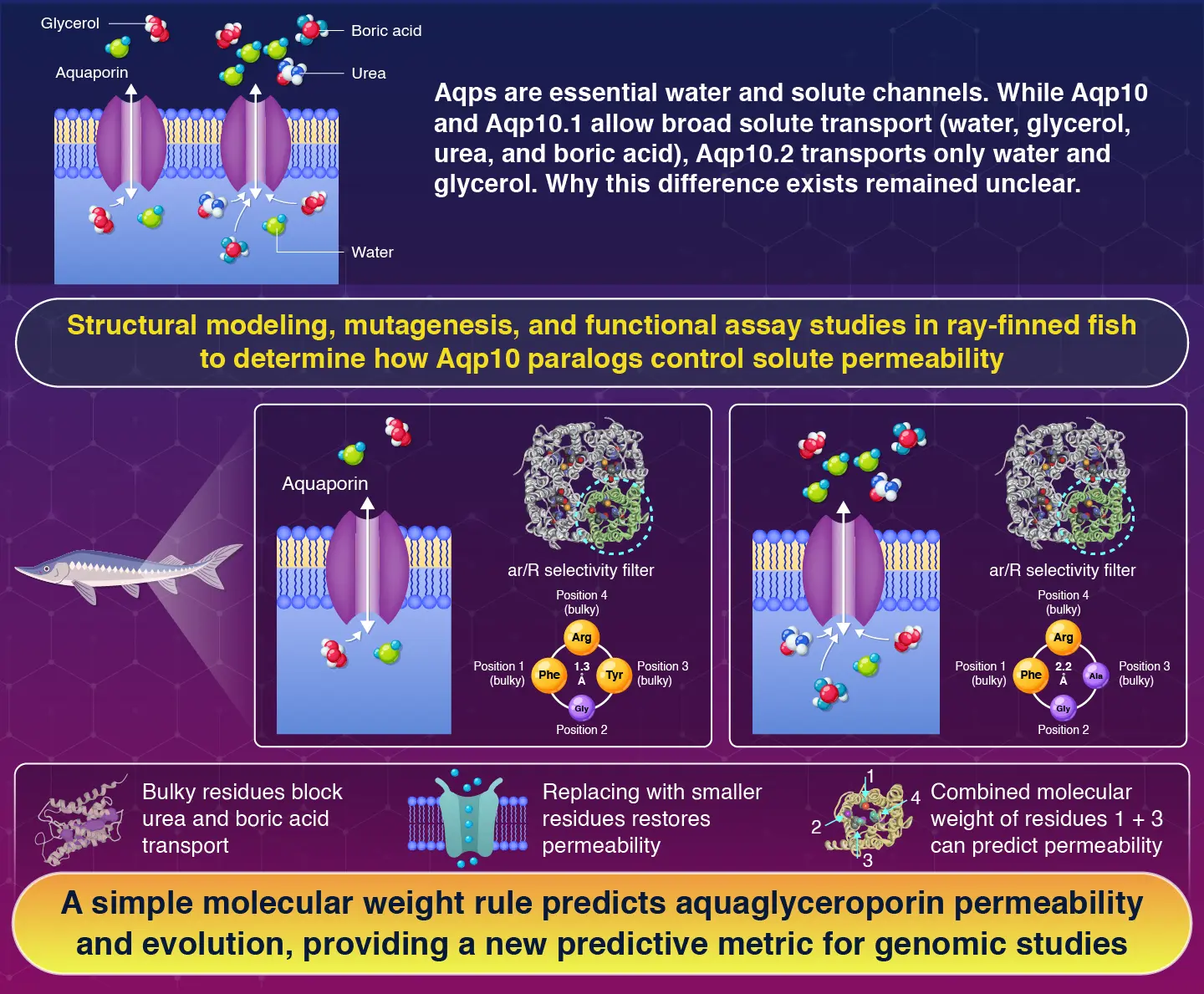Aquaglyceroporin Aqp10, a protein channel for water and glycerol, selectively permeates urea and boric acid due to its unique structural features-report researchers from Japan. By comparing and modeling molecular pore structures in fish species, the team discovered that bulky amino acid residues reduce the pore size of Aqp10-blocking the transport of certain molecules. This not only explains the mechanism of selective permeability but also provides a framework for predicting functions of uncharacterized aquaglyceroporins.
How Amino Acid Filters Shape Solute Selectivity in Aquaporin (Aqp)-10 Paralogs

Nagashima et al. (2025) | American Journal of Physiology-Regulatory, Integrative and Comparative Physiology | 10.1152/ajpregu.00212.2024
From nutrients to signals, every living cell depends on the transport of molecules to stay alive. This transport of molecules occurs through pores or protein channels present in the cell membrane. One example of these protein channels is aquaporin (Aqp), which regulates the flow of water and other molecules across membranes. Aquaglyceroporins are a subtype of Aqps that transport water along with neutral small molecules such as glycerol, urea, and boric acid. However, while some aquaglyceroporins also allow urea and boric acid to pass, others only allow glycerol and water, and the underlying mechanism behind this difference has remained unclear until now.
To bridge this gap, a research team from the Institute of Science Tokyo (Science Tokyo), Japan, led by Associate Professor Akira Kato, then-graduate student Kazutaka Ushio and Assistant Professor Ayumi Nagashima from the School of Life Science and Technology, Science Tokyo, conducted a study to analyze the molecular structures and functions of different versions of aquaglyceroporins, particularly Aqp10. The research was conducted in collaboration with Assistant Professor Tadaomi Furuta from Science Tokyo and Associate Professor Hidenori Nishihara from Kindai University, Japan. The findings of this study were made available online on July 23, 2025, and were published in Volume 329, Issue 3 of American Journal of Physiology – Regulatory, Integrative and Comparative Physiology on August 25, 2025.
"We focused on two versions of aquaglyceroporin Aqp10 present in ray-finned fish species: Aqp10.1 and Aqp10.2. Aqp10.1 is permeable to urea and boric acid, while the Aqp10.2 is not," explains Kato
Using comparative evolutionary physiology and computational modeling, the researchers pinpointed the structural differences between the variants that were responsible for this selective behavior. In Aqp10.2, they found bulky aromatic amino acids positioned at key sites within the channel's pore filter, which reduced its diameter and blocked the passage of urea and boric acid, leaving water and glycerol unaffected. This was not observed in Aqp10.1.
"We observed that two aromatic amino acids at positions 1 and 3 within the four sites of Aqp10's aromatic/arginine selectivity filter were responsible for reducing urea and boric acid permeability," reports Nagashima.
To confirm this assumption, the scientists introduced mutations that swapped the bulky amino acid residues in the porins with smaller residues. Interestingly, this restored the permeability of urea and boric acid. Substituting just one amino acid dramatically increased the channel's ability to transport urea and boric acid without altering the movement of glycerol and water. Further analysis also revealed a clear rule of selectivity; the sum of molecular weights of two critical residues at positions 1 and 3 of the aromatic/arginine selectivity filter was inversely correlated with pore size and permeability. In other words, the heavier the amino acids at these positions, the less permeable the channel.
"This simple metric could allow scientists to predict aquaglyceroporin function directly from genome sequences," claims Kato.
Overall, the discovery helps resolve a long-standing question in membrane biology: how aquaglyceroporins discriminate between molecules of similar sizes. The study also provides a practical framework for researchers to interpret the functions of aquaglyceroporins, especially those with unknown activity, which are increasingly being identified in genomic databases. Furthermore, by linking evolutionary biology with molecular biophysics, the work underscores how subtle changes in protein structure shape fundamental physiological processes.
"Amino acid mutations that occur during evolution are of great interest because they affect structure and function," says Furuta.
As genome sequencing continues to uncover new protein families, the ability to predict transport properties from amino acid sequences could help accelerate discoveries in life sciences—paving the way for advances in biotechnology, medicine, and agriculture.
Reference
- Authors:
- Ayumi Nagashima1,2, Kazutaka Ushio2, Hidenori Nishihara2,3, Jin Akimoto2, Akira Kato1,2* and Tadaomi Furuta1,2
- Title:
- Aquaporin 10 paralogs exhibit evolutionarily altered urea and boric acid permeabilities based on the amino acid residues at positions 1 and 3 in the ar/R region
- Journal:
- American Journal of Physiology-Regulatory, Integrative and Comparative Physiology
- Affiliations:
- 1School of Life Science and Technology, Institute of Science Tokyo, Japan
2School of Life Science and Technology, Tokyo Institute of Technology, Japan
3Department of Advanced Bioscience, Faculty of Agriculture, Kindai University, Japan






